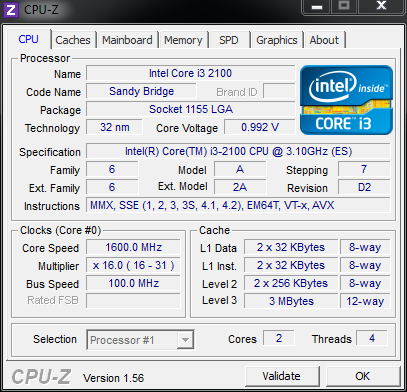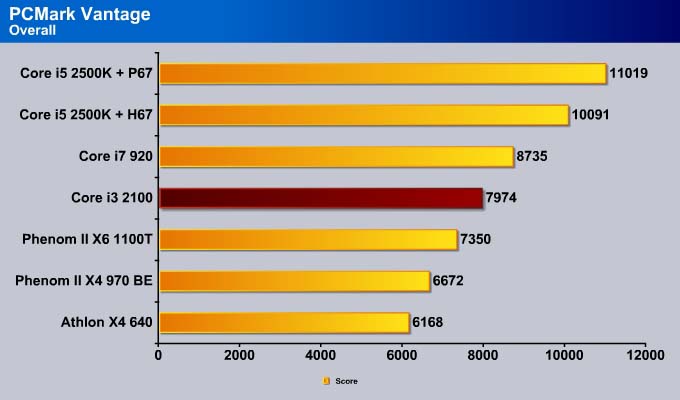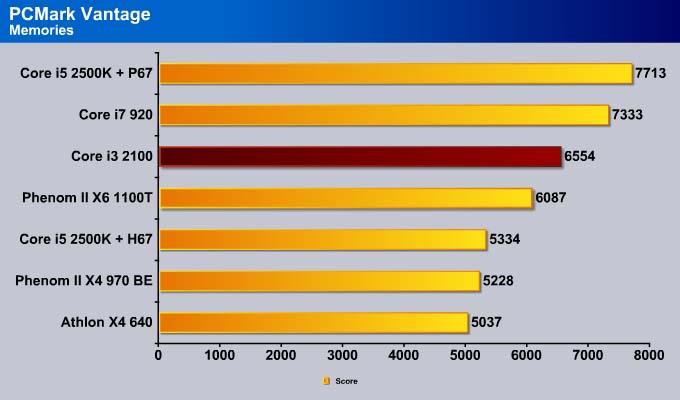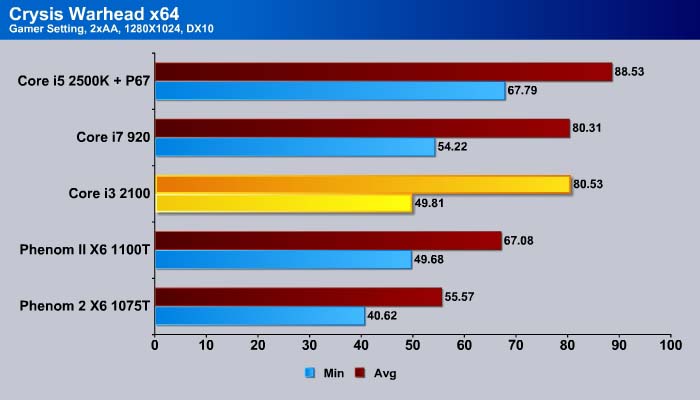Priced at $124, the Intel Core i3 2100 is the cheapest Sandy Bridge processor. For its price and performance, it may just be the best budget processor on the market.
INTRODUCTION
Intel had a major setback with their Sandy Bridge launch due to the Cougar Town chipset defect. However, the issue of defective SATA III ports on Cougar Town chipset boards should not cause too many problems. Nonetheless, because of the chipset problem, the retail sales of the Sandy Bridge board were delayed and retailers halted sales of the processor. About a few weeks ago, replacement B3 stepping boards appeared on e-tail sites such as Newegg, and sales of the second-generation Core series processor have resumed. Those who have been waiting for an upgrade to the Sandy Bridge architecture can began buying the components once again.

Sandy Bridge is probably one of the best processors that money can buy at the moment. It performs well, has low power consumption, and is well within acceptable pricing. We all know that the fastest Sandy Bridge, the Core i7 2600K, is lightning-fast and is almost able to compete against the powerhouse Core i7 980X in all but highly-threaded and extremely memory-intensive applications. But at a third the pricing of the Core i7 980X, it is hard to say no to such a powerful chip. However, not everyone needs the fastest processor, or willing to spend tons of money just to have the bragging rights. Even a budget dual-core can handle most basic tasks such as browsing the web, word processing, and maybe light gaming. The question then becomes how to stay on-budget while still picking the right processor and hardware components to suit the user’s needs.
Intel designed the Sandy Bridge to replace the mainstream processors, so it is natural that the company has unleashed processors that range from the $100 all the way to $300. We have already reviewed the Core i7-2600K and the Core i5-2500K for the enthusiast and mainstream markets. Today, we are going to look at the other side of the spectrum–the $124 Core i3-2100, which is the cheapest Sandy Bridge processor available at the moment.
Intel CORE I3 2100
The Core i3 2100 is a 65W dual-core, four-threaded processor clocked at 3.1GHz. The processor features 3MB cache. While the more expensive and higher clocked Sandy Bridge processors have a Turbo mode that allows the CPU to throttle to a higher clockspeed when not all of the cores are active, the Core i3 does not support such technology. This is understandable, as most software is lightly threaded and is capable of taking advantage of the dual-cores instead of all four cores. So in most cases, both cores on the Core i3 will be active and there is really no need to have a core throttling up and down.
In addition to the lack of the Turbo mode, the Core i3 Sandy Bridge also lacks support for VT-d and AES-NI. For desktop users, the VT-d is probably not something that will be missed as it allows better performance for users of virtualization. Not many people will be running virtualization on their PC but those who do should go for slightly more expensive processors such as the Core i5 for the better performance. The processor also does not support AES, which the more expensive Core i5 and i7 support. The processor supports all other features found on the i5 and i7 such as Execute Disable bit and fast memory access, and flex memory access. The processor also supports SSE4.1/4.2 and AVX for better codecs
For memory support, Core i3 2100 is able to use DDR3-1066/1333 memory up to 32GB. It supports HyperThreading. While the processor does not support Turbo Boost, it still supports Intel’s SpeedStep, which allows the processor to throttle from 1600MHz to 3100MHz depending on the load.
The biggest selling point for the Core i3 2100 and the whole Sandy Bridge line-up is the much needed graphic upgrade from the Clarkdale/Arrandale processor. All Sandy Bridge processors will come with Intel HD Graphics 2000 or 3000. While the more expensive models have the HD 3000, our Core i3 2100 has the HD 2000, clocked at 1100MHz. The base frequency for graphics cards is 850MHz and maximum frequency of 1.1GHz. It supports Intel Quick Sync Video, inTRU 3D, Flexible Display interface, Clear Video HD, and dual display. Readers should remember, though, that only motherboards that are compatible with integrated graphics (such as H67 boards) will be able to use the Sandy Bridge’s onboard graphic. Boards with the P67 chipset will not be able to use the onboard graphics chip.
Furthermore, while the P67 offers overclocking potential, Intel has locked the base clock with the Sandy Bridge processor and leave very little room for overclocking on the unlocked (non-K) processors. The Core i3 2100 of course falls within the non-K series, and does not offer much overclocking headrooms. As such, it is recommended to pair the Core i3 2100 with an H67 chipset motherboard.
Testing & Methodology
We did a fresh load of Windows 7 64 bit on the test rig, then once we updated the software and drivers to the latest versions, we made a clone copy of the hard drive. We ran each test a total of three times and the average of each test is reported here.
Intel system:
- Core i7 920
- Cooler Master V6
- Gigabyte EX58-UD4P
- 6 GB Kingston DDR3 @ 1066 MHz
- Seagate 7200.12
- Asus HD 6870
- Cooler Master UCP 900W
AMD Phenom II X6 system:
- AMD Phenom X6 1100T
- Thermalright SI-128
- 4 GB Kingston DDR3 @ 1600 MHz
- Asus Crosshair IV Extreme
- Seagate 7200.12
- Asus HD 6870
- Cooler Master UCP 900W
Second Intel system:
- Zalman CNPS9900 MAX
- Intel H67 or Asus P67
- 4 GB Kingston DDR3 @ 1600 MHz
- Seagate 7200.12
- Asus HD 6870
- Cooler Master UCP 900W
AIDA64 v1.50

“AIDA64 Extreme Edition is a streamlined Windows diagnostic and benchmarking software for home users. AIDA64 Extreme Edition provides a wide range of features to assist in overclocking, hardware error diagnosis, stress testing, and sensor monitoring. It has unique capabilities to assess the performance of the processor, system memory, and disk drives. AIDA64 is compatible with all current 32-bit and 64-bit Microsoft Windows operating systems, including Windows 7 and Windows Server 2008 R2.”
CPU







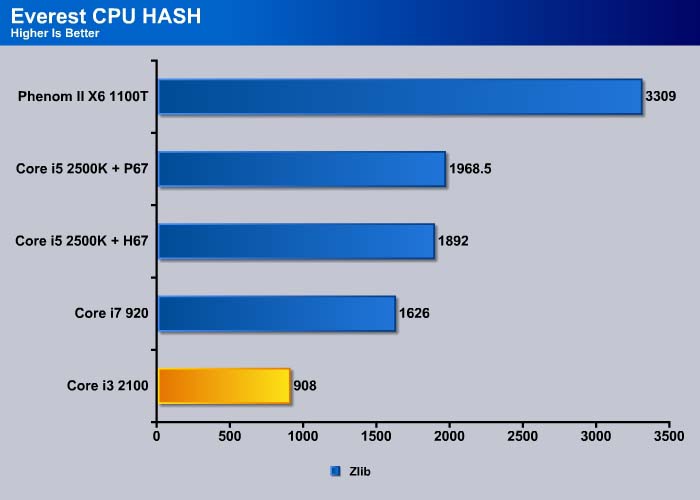

VP8 is also a new benchmark from AIDA64 that measures the video encoding ability of the processor. Obviously with video encoding, having extra cores would definitely pay off. The faster clockspeed on the Core i3 2100 seems to helped out slightly here, and the Core i3 is about 20% slower than the 2.66 GHz Core i7 920 despite the fact that the i7 920 is quad core.
Memory


Intel has refined the memory controller on Sandy Bridge processor and the result is impressive. The Core i3 2100’s memory performance is just a tad slower than the Core i5 2500K but faster than the Core i7 920.
Sisoft Sandra 2011b
“SiSoftware Sandra (the System Analyzer, Diagnostic and Reporting Assistant) is an information & diagnostic utility. It should provide most of the information (including undocumented) you need to know about your hardware, software and other devices whether hardware or software. It works along the lines of other Windows utilities, however it tries to go beyond them and show you more of what’s really going on. Giving the user the ability to draw comparisons at both a high and low-level. You can get information about the CPU, chipset, video adapter, ports, printers, sound card, memory, network, Windows internals, AGP, PCI, PCI-X, PCIe (PCI Express), database, USB, USB2, 1394/Firewire, etc.”
The Core i3’s performance is not too shabby here but it is still not as good as the quad core processors.

Core i3 2100 has good integer point calculation, even beating out the quad-core and six-core processors the Core i5 2500K took the top spot, with the Core i7 920 not too far behind.
Sandy Bridge’s improved memory controller is something that AMD will have to compete with in its next generation of processor.
Cinebench R10 and R11.5

“CINEBENCH is a real-world test suite that assesses your computer’s performance capabilities. MAXON CINEBENCH is based on MAXON’s award-winning animation software, CINEMA 4D, which is used extensively by studios and production houses worldwide for 3D content creation. MAXON software has been used in blockbuster movies such as Spider-Man, Star Wars, The Chronicles of Narnia and many more. MAXON CINEBENCH runs several tests on your computer to measure the performance of the main processor and the graphics card under real world circumstances. The benchmark application makes use of up to 16 CPUs or CPU cores and is available for Windows (32-bit and 64-Bit) and Macintosh (PPC and Intel-based). The resulting values among different operating systems are 100% comparable and therefore very useful with regard to purchasing decision-making. It can also be used as a marketing tool for hardware vendors or simply to compare hardware among colleagues or friends.”

PCMark Vantage
PCMark Vantage is a system benchmark tool from Futuremark. The benchmark consists of tests such as application launches, file searches, web browsing, video playback, photo editing, and gaming. PCMark Vantage is not particularly heavily threaded so it gives a good overview of the processor’s performance under common desktop environment. While the test is purely synthetic, it does offer a good performance perspective.
Overall, the Core i3 2100 scored fairly respectably, beating out the AMD quad and six-core processors. Again, PCMark Vantage is not particularly heavily threaded, so it does not really take the advantage of the six cores.
Intel has made a big improvement with the Sandy Bridge’s memory controller: the Core i3 2100 comes in just behind the Core i5 2500K and the Core i7 920.
The TV and Movies test consists of transcoding video. This is one area where having more cores will have a clear advantage. Intel made some changes with the Sandy Bridge so the processor line has a big improvement in video transcoding. Thus, we see the Core i3 2100 actually beats out the Athlon II X4 640 despite the i3’s two cores versus the Athlon II’s four.
PCMark Vantage gaming shows the best case scenario, so readers should take this score with a grain of salt. Still, as we can see faster communication between the processor and memory subsystem, Sandy Bridge does offer some improvements in gaming. Most games are not too heavily threaded so even a dual-core processor such as Core i3 2100 paired with a good mainstream card like the GTX 560 Ti or the AMD HD 6850 could be powerful enough to drive games up to 1920×1080 resolution.
The PCMark Vantage Music test consists of transcoding MP3 to WMA and adding music to Windows Media Player. This task is not particularly heavy threaded so the faster processing power instead of number of the cores often dictates the performance. The Core i3 2100 does well here.
The PCMark Vantage Communications suite involves light multitasking of data encryption and web page rendering.
The Productivity test involves four simultaneous tasks that consist of searching contacts in Windows Contacts, searching emails, web page rendering, and application loading. This test simulates common desktop usage with multiple tasks being processed at the same time.
The HDD suite tests the hard drive performance, so it does not particularly reflect the CPU performance. It also depends on the motherboard chipset.
SysMark 2007 Preview
SYSMark 2007 Preview is a tool developed by Bapco that supports both 32bit and 64bit Windows XP, Vista, and 7. The benchmark is application-based reflecting the usage pattern of the common desktop user. The benchmark focuses in four areas: E-learning, 3D, Productivity, and Video Creation. While the test is designed primarily for testing processors, it can also used to reflect hard drive performance in real-life scenarios. This gives us a great idea on how the processor performs under these CPU intensive applications.
Sysmark is yet another real-life test suite that tests various common desktop applications.
The E-Learning test suit consists of Microsoft PowerPoint 2003, Adobe Photoshop CS2, Adobe Flash 8, and Adobe Illustrator. The test consists of tools used for creating web based interactive applications.
The Productivity test consists of Microsoft Office Suite (Project, Excel, Outlook, PowerPoint, and Word) and WinZip. This test simulates common office applications and is a good indicator of the processor’s utility under common desktop usage.
Much like PCMark Vantage, Sysmark 2007 is a synthetic benchmark and not too heavily threaded. The Core i3 2100 performs quite well in these tests, often coming ahead of the Core i7 920 or the Phenom II X6 1100T. The only test where the processor falls behind is in the Video Creation, where as expected, the quad- and six-core processors have a clear advantage over the dual-core.
3DMark Vantage
For complete information on 3DMark Vantage Please follow this Link:
www.futuremark.com/benchmarks/3dmarkvantage/features/
The newest video benchmark from the gang at Futuremark. This utility is still a synthetic benchmark, but one that more closely reflects real world gaming performance. While it is not a perfect replacement for actual game benchmarks, it has its uses. We tested our cards at the ‘Performance’ setting.
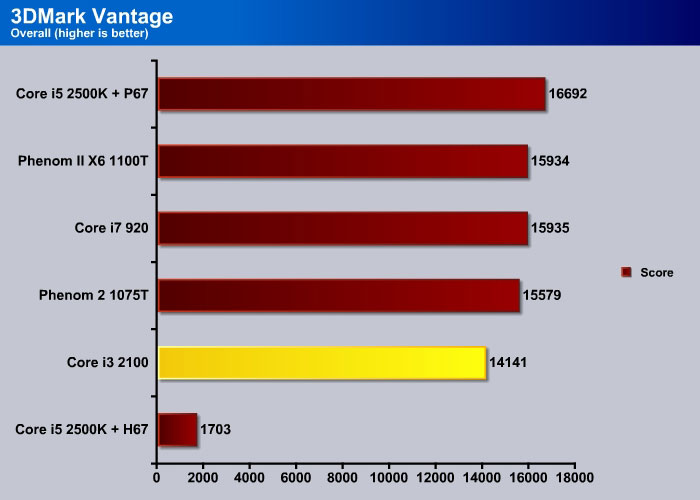


Crysis warhead
Crysis Warhead is the much anticipated standalone expansion to Crysis, featuring an updated CryENGINE™ 2 with better optimization. It was one of the most anticipated titles of 2008.
We ran Warhead using gamer’s setting at resolution of 1280×1024 and DirectX 10. We tested both no AA an 2x AA.
Crysis Warhead is not particularly heavily threaded so the Core i3 2100 performs quite well here.
Dirt 2
Dirt 2 is the squeal to the popular racing game Colin McRae Dirt. This is a standard racing game, but with an off road twist. Instead of racing Bugattis and Porsches, players race trophy trucks and rally cars.
At medium game setting, the Core i3 2100 is behind the Core i7 920.
High-Performance Gaming:



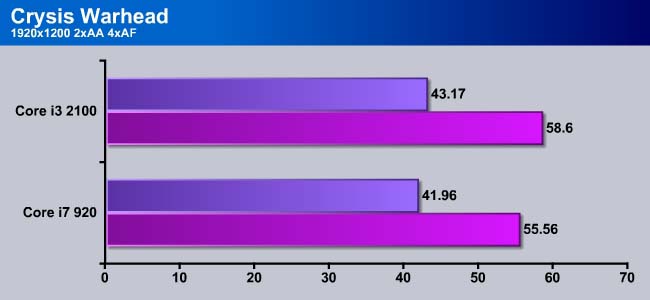

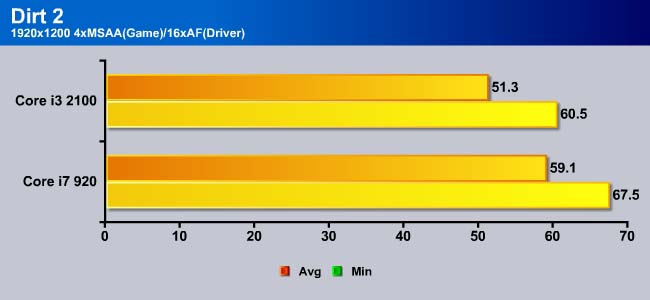

POWER CONSUMPTION
We ran Prime95 to stress the CPU in order to measure the overall system power consumption. All of the power saving features (C&Q and SpeedStep) have been enabled, as we envision this is how most people will be running their system.
Idling, the Core i3 2100 consumes the same amount of power as our Core i5 2500K. Both processors consume 83W idle. Under load, the Core i3 2100 is 25W less than the Core i5 2500K, which is what we expect since the Core i5 2500K is a 95W processor while the Core i3 2100 is a 65W processor. The Core i7 920 draws in a whopping 264W of power under load, even more than the six-core processors.
In terms of temperature, the processor idles at 26°C and under load, it reaches to 48°C when it is paired up with the Zalman CNPS9900 MAX.
CONCLUSION
Do not be fooled by the $124 pricing of the Core i3 2100. The processor is not a sloth. While it is not able to compete against a true quad-core when it comes to heavily threaded application, thanks to hyperthreading, it is more than capable in lightly-threaded applications, often coming out above AMD quad core processors. The processor is in direct competition against the AMD Phenom II X4 and Athlon II X4, often excelling in lightly threaded tasks. In most basic applications such as web-browsing, word processing, and media streaming, the Core i3 2100 is more than enough, and comes on top. The only area where the processor cannot compete is in thread-intensive applications such as video encoding and 3D rendering, where the quad-core processors still have an edge.
The processor does face some competition because the AMD Phenom II X4 955 BE can be purchased for $20 more and the Phenom II X4 840 costs $20 less. For those who need extra power and often use heavily threaded application, we would suggest buying true quad-core processor. However, for those who simply need a budget system for lightly-threaded applications, the Intel Core i3 2100 is a very capable processor. The processor is ideal for a budget system or HTPC because of its low power consumption and heat output. Pairing this up with an Intel H67 chipset motherboard would be a good combination, especially since Intel’s integrated HD 2000 graphics are decent enough to handle the graphical requirements and video decoding thanks to Quick Sync and AVX extension.
| OUR VERDICT: Intel Core i3 2100 | ||||||||||||||||||
|
||||||||||||||||||
| Summary: The Intel Core i3 2100 is a very capable dual-core processor that offers excellent price for its performance. While it cannot compete against true quad-core processors in heavily threaded tasks, it is more than capable in lightly threaded applications, where it often excels. For its excellent price to performance ratio, the processor has earned the Bjorn3D Seal of Approval. |
 Bjorn3D.com Bjorn3d.com – Satisfying Your Daily Tech Cravings Since 1996
Bjorn3D.com Bjorn3d.com – Satisfying Your Daily Tech Cravings Since 1996


